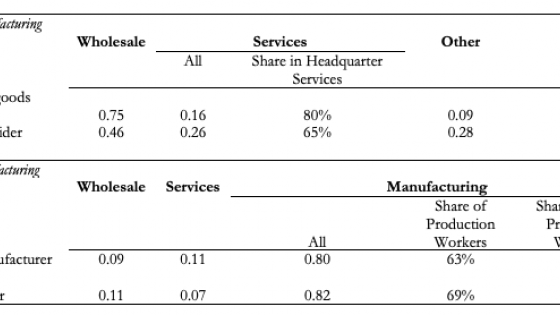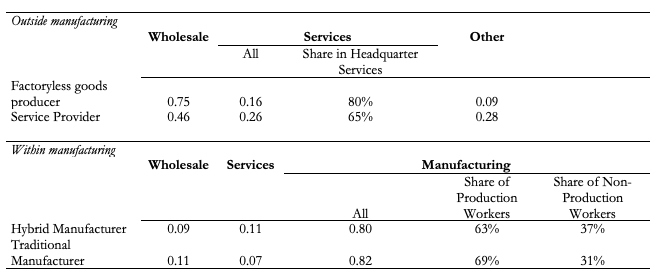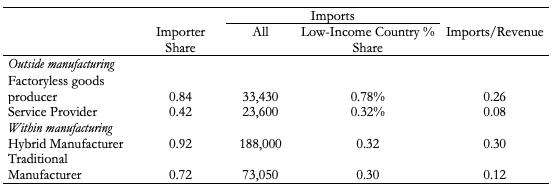What are ‘factoryless’ goods producers? What role do they play in the US economy? These are key measurement questions facing US statistical agencies with increased fragmentation of the goods production process. An extreme form of fragmentation entails outsourcing the physical transformation activities while retaining ownership of the intellectual property and controlling sales to customers, giving rise to the so-called factoryless goods producers. Identifying factoryless goods producers accurately in statistical data collections is the first step to assess their importance in the national economy.
Previous efforts to measure this phenomenon focused primarily on the establishment level (Bayard et al. 2015, Bernard and Fort 2013, Murphy 2015). In a recent paper (Kamal 2018), I explore the feasibility of identifying factoryless goods producers which are firms across all sectors of the US economy. I utilise responses to a question on the purchase of contract manufacturing services asked to both firms and their establishments in 2012.1 Purchase of contract manufacturing services indicates whether an establishment outsources part or all of its production transformation activities to another establishment.2 I also utilise detailed information on firms’ manufacturing and non-manufacturing employment, research and design expenditures, patents, trademarks, and merchandise imports.
Considering factoryless activity as a firm-level concept is motivated by the observation that the firm is the central-decision maker that controls and coordinates the key economic activities of design, production, and sales, with each of its establishments specialising in a given activity. Hence, company headquarters, which possess comprehensive knowledge of the firm’s operations, may be better suited to respond to questions intended to identify factoryless goods producers.
I combine two distinct strategies for identifying factoryless goods producers – self-identification by companies and their establishments in statistical surveys, and implementation of a profiling method based on conceptual definitions. I operationalise the conceptual definition of factoryless production along four main attributes:3
- ownership of intellectual property (proxied by research and development expenditures, number of patents, and number of trademarks);
- ownership and sales of finished goods (measured as revenue);
- incidence of borderless production arrangements (measured as merchandise imports);
- incidence of ‘headquarter’ activity encompassing strategic or organisational planning and decision making activities (measured as employment in Professional, Scientific, and Technical Services and the Management of Companies and Enterprises).
The analysis begins by classifying firms into three types of goods producers:
- Factoryless goods producers – firms in the services or wholesale trade sectors that outsource all production activities and do not have any domestic manufacturing plants;
- Hybrid manufacturers – firms in the manufacturing sector that outsource some production activities but also own domestic manufacturing plants;
- Traditional manufacturers – firms in the manufacturing sector that do not outsource any production and perform all production-related activities at own domestic plants;
In addition, I classify:
- Service providers – firms in the services or wholesale trade sectors that do not undertake any manufacturing activity.
Then, I perform two separate sets of comparisons of characteristics guided by the conceptual definition of factoryless production. Tables 1 through 4 in the appendix below show firm employment shares by sector, innovative activity, importing activity, and selected firm characteristics, respectively. I compare factoryless goods producer firms to service providers outside the manufacturing sector (results in top panel of tables), and hybrid manufacturers to traditional manufacturers within the manufacturing sector (results in bottom panel of tables).
Factorlyess goods producers vs service providers
Factoryless goods producer firms, on average, have most of their employment in the wholesale trade sector and the remaining almost evenly divided between services and other sectors of the economy. Factoryless goods producer firms with employment in the services sector have the majority of their workers engaged in the provision of ‘headquarter’ services that include management and R&D activities. In contrast, only a third of services workers at service providers are engaged in the provision of headquarter services. Factoryless goods producer firms also have substantially higher values of R&D expenditures and counts of granted patents and trademarks than service providers consistent with greater ownership of intellectual property.
Factoryless goods producer firms may use factories located in foreign countries to manufacture the goods they control increasing the likelihood of importing the foreign-produced goods for domestic sale or further processing. I find that factoryless goods producer firms are more likely to be importers relative to service providers. Further, if lower labour costs motivate factoryless goods producer firms to use foreign factories, we would expect to see higher shares of imports from low-wage countries at factoryless goods producer firms. Although imports from low-income countries are a very small share of total firm imports (less than 1%) at both factoryless goods producer and service providing firms, the average share of imports from low-wage countries is almost twice as high at factoryless goods producer firms. Finally, imports as a share of firm revenue are more than three times higher at factoryless goods producer firms. Together, these results suggest that factoryless goods producer firms are more likely to utilise borderless production arrangements than service providers.
Factoryless goods producer firms earn lower average revenue than service providers. Factoryless goods producer firms also employ almost three times fewer workers, have smaller payroll, and own fewer establishments than service providers. These findings are in contrast to Bernard and Fort (2015) who find that factoryless goods producer firms in the wholesale trade sector tend to be larger than traditional wholesalers. However, there is no obvious prediction for firm size and factoryless status. Outside the manufacturing sector, factoryless goods producer firms may employ fewer workers at fewer establishments than service providers, if non-production activities focused on managing production transformation tasks require fewer workers and physical facilities. Factoryless goods producer firms may also display lower sales if they are more likely than service providers to locate production and sales abroad.
Hybrid vs traditional manufacturers
Hybrid manufacturers have the majority of their employment housed in the manufacturing sector, however, they have lower shares of production workers than traditional manufacturers. This is consistent with hybrid manufacturers outsourcing part of production. R&D expenditures, number of patents and trademarks are, on average, higher at hybrid than traditional manufacturers. These patterns suggest that even hybrid manufacturers that outsource only a part of the production transformation process display patterns in ownership of intellectual property that are consistent with the conceptual definition of factoryless production. Average trade characteristics yield a set of correlations that are consistent with the idea that hybrid manufacturers may use foreign factories to manufacture goods more intensively than traditional manufacturers. Hybrid manufacturers are substantially more likely to import and have higher shares of imports from low-wage countries than traditional manufacturers.
Hybrid manufacturers are larger than traditional manufacturers in terms of average revenue, employment and payroll. However, hybrid manufacturers own fewer establishments suggesting that firms require fewer physical plants when part of the production is outsourced. Hybrid manufacturers have higher average payroll per worker and average revenue per worker. Both types of manufacturers tend to be older (around 29 years).
This analysis reveals meaningful correlations between factoryless status at the firm level and variables identified based on conceptual definitions – employment mix, innovation, and importing activities. The unconditional correlations merit further study building towards developing a model-based algorithm to identify factoryless goods producer firms and assessing their role in the US economy.
Author’s note: Any opinions and conclusions expressed herein are those of the author and do not necessarily represent the views of the US Census Bureau. All results have been reviewed to ensure that no confidential information is disclosed.
References
Bayard, K, D Byrne and D Smith (2015), “The scope of US factoryless manufacturing”, in Houseman, S and M Mandel (eds.), Measuring globalization: Better trade statistics for better trade policy, Volume 2, 81-120, Kalamazoo: W.E. Upjohn Institute for Employment Research.
Bernard, A B and T C Fort (2015), “Factoryless goods producing firms”, American Economic Review Papers and Proceedings 105(5): 518-23.
Bernard, A B and T C Fort (2013), “Factoryless goods producers in the US”, NBER working paper 19396.
Doherty, M (2015), “Reflecting factoryless goods production in the US statistical system,” in Houseman, S and M Mandel (eds.), Measuring globalization: Better trade statistics for better trade policy, Volume 2, 13-43, Kalamazoo: W.E. Upjohn Institute for Employment Research.
Kamal, F (2018), “A portrait of US factoryless goods producers”, NBER working paper 25193.
Murphy, J (2015), “Identifying factoryless goods producers (FGPs) – efforts to date”, United Nations Economic Commission for Europe, Conference of European Statisticians, Group of Experts on National Accounts.
Appendix
Table 1 Firm employment shares by broad sectors, 2012
Notes: This table displays firms’ average share of sectoral employment. Factoryless goods producer: firms that purchase contract manufacturing services and do not have manufacturing employment; Service Provider: firms that do not purchase contract manufacturing services and do not have manufacturing employment. Hybrid Manufacturer: firms that purchase contract manufacturing services and have manufacturing employment; Traditional Manufacturer: firms that do not purchase contract manufacturing services and have manufacturing employment. ‘Headquarter Services’ refers to employment in NAICS 54 (Professional, Scientific, and Technical Services) and NAICS 55 (Management of Companies and Enterprises). ‘Other’ refers to employment in retail, agriculture, transportation, warehousing and utilities, construction, and public administration.
Table 2 Firm innovative activity, 2012
Notes: This table displays firms’ average R&D expenditures, ownership of number of granted patents and trademarks. Factoryless goods producer: firms that purchase contract manufacturing services and do not have manufacturing employment; Service Provider: firms that do not purchase contract manufacturing services and do not have manufacturing employment. Hybrid Manufacturer: firms that purchase contract manufacturing services and have manufacturing employment; Traditional Manufacturer: firms that do not purchase contract manufacturing services and have manufacturing employment. R&D spending based only on firms surveyed in the Business R&D and Innovation Survey. R&D spending in 1,000 USD.
Table 3 Firm importing activity, 2012
Notes: This table displays firms’ average merchandise importing characteristics. Factoryless goods producer: firms that purchase contract manufacturing services and do not have manufacturing employment; Service Provider: firms that do not purchase contract manufacturing services and do not have manufacturing employment. Hybrid Manufacturer: firms that purchase contract manufacturing services and have manufacturing employment; Traditional Manufacturer: firms that do not purchase contract manufacturing services and have manufacturing employment. Importer share is the fraction of firms that report positive imports. Imports/Revenue is the ratio of imports to total firm revenue. Low-income countries defined using United Nations’ country classification. Imports in 1,000 USD.
Table 4 Firm characteristics, 2012
Notes: This table displays average firm characteristics. Factoryless goods producer: firms that purchase contract manufacturing services and do not have manufacturing employment; Service Provider: firms that do not purchase contract manufacturing services and do not have manufacturing employment. Hybrid Manufacturer: firms that purchase contract manufacturing services and have manufacturing employment; Traditional Manufacturer: firms that do not purchase contract manufacturing services and have manufacturing employment. Revenue and payroll in 1,000 USD.
Endnotes
[1] I use the Economic Census (establishment level) and the Company Organisation Survey (firm level) in the analysis. The Economic Census refers to the Census of Manufactures, Census of Wholesale Trade, and Census of Services. Establishments in every six-digit industry within Manufacturing, Wholesale Trade, and Professional Scientific, and Technical Services, and establishments in Corporate, Subsidiary, and Regional Managing Offices were legally required to respond to the inquiry on the use of contract manufacturing services.
[2] Contract manufacturing is an arrangement wherein a manufacturer provides services to the owner of the design, specifications and output produced. Manufacturing includes the mechanical, physical or chemical transformation of materials, substances, or components into new products. See https://www.census.gov/econ/esp/definitions.html.
[3] See Doherty (2015) for development of the factoryless goods producer definition.







